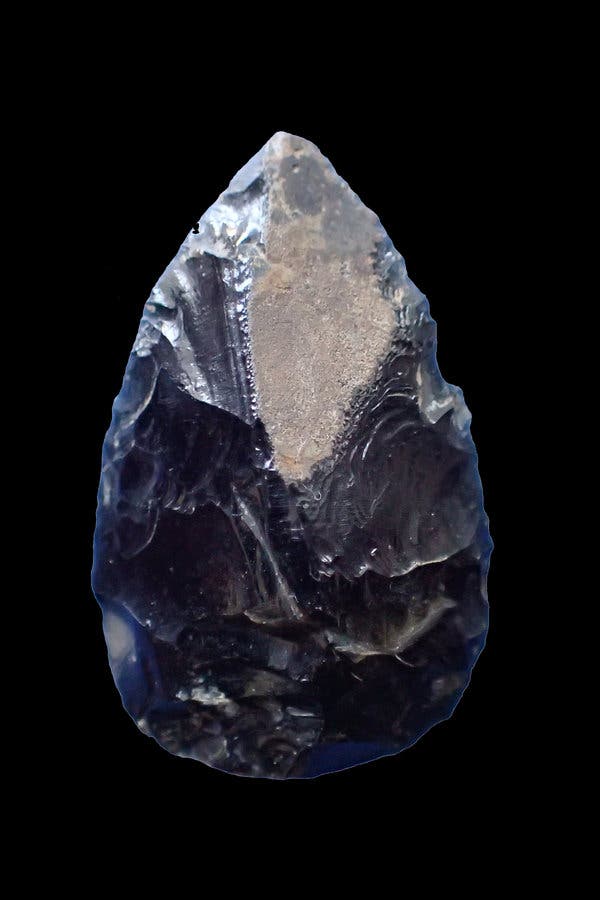Scientists have discovered what is by far the oldest evidence of human occupation at extreme altitudes: a rock shelter strewn with bones, tools and hearths 11,000 feet above sea level. People lived at the site, in the mountains of Ethiopia, as long as 47,000 years ago.
The research, reported on Thursday in the journal Science, contradicts the long-held view that high elevations were the last places on Earth settled by humans.
That notion was based more on assumptions than hard evidence, it now appears. In East Africa, paleoanthropologists have long focused their attention on the Rift Valley and other archaeological sites at lower elevations.
“We were simply the first to go higher,” said Götz Ossendorf, an archaeologist at the University of Cologne in Germany and lead author of the new study.
The high-altitude humans thrived as hunter-gatherers, subsisting on roasted giant mole-rats and glacier-fed streams. They crafted stone tools from a nearby outcrop of obsidian. And they occupied the rock shelter, off and on, for at least 16,000 years.
Humans have managed to settle into a huge range of habitats, from searing deserts to the Arctic tundra. But extreme altitudes pose special challenges. The weather can be brutal, and extreme altitudes don’t support lush forests or grasslands, as lower elevations do. Low levels of oxygen can be dangerous, sometimes even fatal, to humans at high elevations.
“Our hominid ancestors were born lowlanders,” said Mark Aldenderfer, an archaeologist at the University of California, Merced, who was not involved in the new study.

CreditG. Ossendorf
Despite these challenges, people eventually moved uphill. Today, in Ethiopia, the Andes and Tibet, humans live year-round at high elevations. Archaeologists have assumed that these places were among the last to be settled.
But in recent years, expeditions to mountains and plateaus have turned up remarkable clues of human occupation tens of thousands of years ago. In 2018, for example, a team of researchers working on the Tibetan Plateau found stone blades and other artifacts dating back over 30,000 years.
More recently, another team discovered the 160,000-year-old jawbone of an extinct human relative, known as a Denisovan, in a high-elevation Tibetan cave.
In Africa, even more tantalizing clues have come to light. Simple stone tools have been found at high elevations in Ethiopia, and they appear to be hundreds of thousands of years old. They might have been left there by members of our species — or an earlier hominid species.
Still, it’s hard to know whether these findings mean that humans were living at these altitudes, or just making a brief sojourn.
“Any of us can walk up to high elevation and spend six weeks up there,” said Dr. Aldenderfer. “But we know we will have trouble living there permanently, especially if we’re trying to create societies up there and have children.”
To get a deeper understanding of life at high elevations, Dr. Ossendorf and his colleagues began a project in the Bale Mountains of southern Ethiopia in 2015.
They traveled over 700 miles on foot and with pack horses in search of signs of early human occupation. They visited overhanging cliffs to see if people had ever used them as shelters.
The archaeologists found 331 rock shelters with signs of human occupation. Almost all had been visited in recent centuries by livestock herders, making it difficult to examine the sites for truly ancient human remains.
But one rock shelter had gone undisturbed by modern herders, thanks to its low ceiling. When the scientists dug into the shelter floor, they quickly turned up hearths, animal bones and tools — evidence that people once lived there.
The tools surprised the researchers, because they were made in the distinctive style of the Middle Stone Age, which lasted from about 300,000 years ago to 28,000 years ago — far older than the researchers had expected.
“That was breathtaking,” Dr. Ossendorf recalled.
To establish the age of the site, called Fincha Habera, the team analyzed carbon from charcoal still in the hearths. It ranged from 47,000 to 31,000 years old.
The menu at Fincha Habera was dominated by one entree, the researchers found: giant mole-rats, a species that lives today only in the Bale Mountains. The residents may have smoked the animals out of their tunnels and killed them, cooking the mole-rats over fires and pulling the meat from the bones.
[Like the Science Times page on Facebook. | Sign up for the Science Times newsletter.]
The Fincha Habera people made a great number of obsidian tools, but it’s not certain what they were used for. It is clear that the inhabitants didn’t bring the tools from the lowlands — the researchers traced the rock to an outcrop nearby, at an elevation of over 13,700 feet.
Fincha Habera had other attractions, it turns out. During the Ice Age, parts of the Bale Mountains were covered by glaciers that fed rivers year-round. The rivers were flanked by forests that may have been home to antelope and other game that people may have hunted.
Some researchers have viewed extreme altitudes as refuges of last resort, where people went only if the surrounding lowlands became unlivable. But at the time that people lived at Fincha Habera, the lowlands were wet and had plenty of game, said Lars Opgenoorth, an ecologist at Philipps University Marburg in Germany and a co-author of the study.
People living in Fincha Habera, he argued, were not fleeing conditions somewhere else. “They thought it was a good place to be,” he speculated.
Dr. Opgenoorth and his colleagues are planning a new expedition to Fincha Habera to dig deeper into the floor of the rock shelter. This time, they hope to find bones of the inhabitants.
“It would be really cool if they could find human remains — and it would be even cooler if they could get DNA from that,” said Emilia Huerta-Sanchez, a geneticist at Brown University in Providence, R.I.
Dr. Huerta-Sanchez and other geneticists have found that life at high altitudes can shift human evolution into high gear. People in the Andes and elsewhere have inherited genetic adaptations that keep them healthy at low levels of oxygen.
If researchers were to recover ancient DNA from human fossils at Fincha Habera, they could scan it for genetic adaptations to high altitude. Those genes may even be carried by living Ethiopians.
“I would like to believe it’s true, but we need more evidence,” said Dr. Huerta-Sanchez.
Fincha Habera probably was not the first high-elevation home that humans made. Middle Stone Age tools in Africa can be 300,000 years old. If people thrived at Fincha Habera with those tools, then forebears might have done so thousands of years earlier.
“Now we would almost expect even older findings will be made,” Dr. Ossendorf said.




